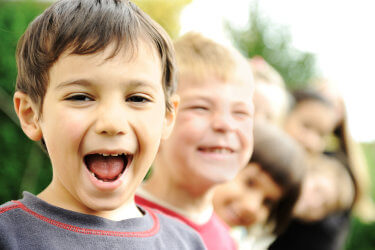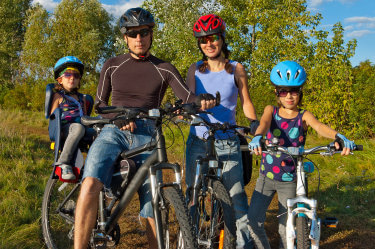(Publisher’s Note: This article is based on a presentation made by the author as part of the 50 Million Strong by 2029 Forum held at the 2017 SHAPE America National Convention.)
In 2015, SHAPE America unveiled something new entitled 50 Million Strong by 2029 (50MS) at its Seattle National Convention. Immediately, people asked, “What exactly is this 50MS?” I’ve heard it described differently: A program, a curriculum, an initiative. Some disparagingly described it as just another one of SHAPE America’s gimmicks, or the dumbing down of physical education to just getting kids active. In fact, 50MS is defined as a commitment to ensuring that by the year 2029 all children who started school in 2015 will, by the time they graduate from high school in 2029, have the skills, knowledge and disposition to lead healthy and physically active lives. Admittedly, following its unveiling, SHAPE America perhaps fell short in how 50MS was presented, described, and operationalized. However, at its core 50MS is a tangible goal, or target for the profession to shoot for over the next 12 years. And whether or not 50MS succeeds depends on what the field as a whole (i.e. teachers, teacher education programs, and our state, district and national association), opts to do to achieve that goal.

Fundamentally, 50MS has its roots in two key trends. First, there is the well-documented rise in overweight and obesity levels among children and youth (among others) that gave rise to health-oriented physical education (e.g., Metzler, McKenzie, van der Mars, Williams, & Ellis, 2013a, 2013b; Sallis & McKenzie, 1991; Sallis, McKenzie, Beets, Beighle, Erwin, & Lee, 2012). The Comprehensive School Physical Activity Program (CSPAP) model was introduced principally in response to the concerns surrounding overweight and obesity (NASPE, 2008). But to be clear, the CSPAP framework emphasizes quality physical education as its centerpiece component!
Second, there is physical education’s growing marginalization; a long-standing condition not just in the USA, but globally as well (Hardman, 2008) with multiple underlying reasons. These include the continued obsessive pressure on improving students’ academic performance, unstable school funding, a lack of assessment culture, and the recent rise of school voucher programs at both the federal and state levels. In many high schools, athletic “mission creep” has all but made physical education a wholly-owned subsidiary of the schools’ athletic department (van der Mars, 2017). However, perhaps the most important reason for physical education’s continued marginalization is the lack of strong state-level policies that support the delivery of effective physical education programs (SHAPE America, 2016).
As teaching professionals, we ourselves rightfully view that what we do is central to the education of children and youth. We continuously remind each other about that at our professional development workshops and our state and national conventions. But until those beyond our own professional community view our work as such, we will never reach legitimacy and credibility (Sallis & McKenzie, 1991).

So Why Get On the 50MS Bus?
In the movie “Moneyball,” Oakland A’s General Manager Billy Beane, after opting to take a radically new approach to building a successful team, is confronted by one of the organization’s senior scouts who claims this new approach is doomed to fail. Billy Beane’s response is simple: “Adapt or die.” It’s the same for physical education: We cannot afford to keep doing the same thing we have been doing for many decades and expect better or even different results.
Currently, schools are viewed by many to be a key institution in the broader efforts to promote physical activity and thus improve the nation’s public health status (e.g., NPAPA, 2016; IOM, 2013; Pate et al., 2006). School physical education alone cannot solve this public health problem. But fortunately, many other agencies, professions, and institutions share this interest. Today, we should celebrate the fact that our field is being asked to be at the table of players whose collective efforts could help solve a national health crisis. Outside of the profession, others are recognizing and respecting our potential contribution and influence. For many years, our profession has craved respect. Why would we decline an opportunity to become a major player on this national team?

What if I Choose NOT to Get On the Bus?
The 50MS target is or should be a powerful unifier for our profession. Instead, it has created an artificial split between two camps. On one side, we have the skill development devotees, who on principle choose to view physical education programs primarily as the vehicle for promoting “skill development in the motor domain.” On the other side, we have our physical activity promotion troubadours with an eye toward contributing to the public health of the nation. Significantly, the latter group has never claimed that skill development is notimportant in the process of promoting physical activity for later life.
As Blankenship (2013) noted, these two perspectives are, in fact, two sides of the same coin. Moreover, there is evidence that both goals are within reach (Harvey et al., 2016). Stated differently, one cannot be successful without the other. History shows us that a strict adherence to a “skill development” approach without a focus on promoting physical activity beyond the classroom has not worked. Increasing the physical activity levels of ALL students is a legitimate and credible program outcome and is already featured within the national content standards (SHAPE America, 2013). Choosing to not include a physical activity focus, alongside developing competence in skills, tactics, and knowledge risks causing us to miss the last bus that can possibly move the field forward. Even worse, continuing to take this “either-or” position may well prove our undoing.

What if I Cannot Fit On the Bus?
As noted above as well as by other 50MS authors, success in reaching the 50MS goal is not without complex barriers and challenges that need to be overcome. But engagement in physical activity into adulthood is something we all claim to be our overarching goal. Whether teachers choose a fitness-, outdoor-, or sport-focused experience is not the issue. It is how they shape these experiences through faithful implementation of curricular models and evidence-informed instructional practices that will help determine success. Thus, seats on the bus will not be oversold: There is room for everyone! 50MS offers a unique unifying opportunity for SHAPE America and the field at large to reach credibility and legitimacy.
Importantly, a strong focus on promoting physical activity beyond physical education lessons does not mean that all physical education teachers need to do is get students to be active (much like in the proverbial “busy, happy, good” syndrome [Placek, 1983]). This would be a serious misinterpretation. Similarly, making all physical education be focused on just physical fitness will likely also be counterproductive. Just like not everyone is attracted to sport, the same also holds true for fitness.

How Will We Know We Got There?
Without legitimate student and/or program-focused metrics we will never know. SHAPE America is developing a dashboard aimed at tracking progress. The current plan is to track progress in both process and product-focused outcomes on an on-going basis. This will allow for adjustments in policy development, assessment, continuous professional development efforts, etc. Much like the Healthy People initiative, which started in 1990, interim objectives will need to be adjusted. If by 2029 we reach the 35 million mark, it does not mean that the whole 50MS focus was a waste of time or a failure.
In closing, the goal of SHAPE America’s 50MS commitment is not in providing the magic bullet or a single solution. The solution – and the challenge before us – lies in how the field creates the conditions for students to succeed. And by the field, I mean K-12 physical educators, higher education faculty, our state- and district associations, and SHAPE America itself. Some examples of ways to increase the likelihood of success include: a) improving state-level policy profiles that support physical education, b) supporting teachers through continuing professional development, c) ensuring that schools employ evidence-informed instructional and curricular practices, d) making appropriate use of technology, and e) making adjustments in the preparation of future physical education professionals.
Ultimately, reaching 50MS by 2029 is contingent on how teachers, our professional associations, physical education teacher educators, and researchers help create conditions for success. In the end, we all need to remember that what we do is ultimately about the well-being of current and future generation of students.
~Please post your thoughts and comments in the discussion section below this article~
References
Blankenship, B. (2013). Knowledge/skills and physical activity: Two different coins, or two sides of the same coin? Journal of Physical Education, Recreation and Dance, 84(6), 5–6.
Hardman, K., & Marshall, J. (2009). Physical education in schools: A global perspective. Kinesiology, 40(1), 5–28.
Harvey, S., Song, Y., Baek, J., & van der Mars, H. (2016). Two sides of the same coin: Student physical activity levels during a game-centered soccer unit. European Physical Education Review,22, 411–429. doi: DOI: 10.1177/1356336X15614783
Institute of Medicine (IOM). (2013). Educating the Student Body: Taking Physical Activity and Physical Education to School. Washington DC: The National Academies Press.
Metzler, M.W., McKenzie, T.L., van der Mars, H., Williams, L.H., & Ellis, S.R. (2013a). Health Optimizing Physical Education (HOPE): A new curriculum model for school programs-Part 1: Establishing the need and describing the curriculum model. Journal of Physical Education, Recreation and Dance, 84(4), 41-47.
Metzler, M.W., McKenzie, T.L., van der Mars, H, Williams, L.H., & Ellis, S.R. (2013b). Health Optimizing Physical Education (HOPE): A new curriculum model for school programs-Part 2: Teacher knowledge and collaboration for HOPE. Journal of Physical Education, Recreation and Dance, 84(5), 25-34.
Miller, A., Christensen, E., Eather, N., Gray, S., Sproule, J., Keay, J., & Lubans, D. (2016). Can physical education and physical activity outcomes be developed simultaneously using a game-centered approach? European Physical Education Review, 22, 113-133. doi: 10.1177/1356336X15594548
National Association of Sport and Physical Education (NASPE). (2008). Comprehensive School Physical Activity Programs. Reston, VA: Author.
National Physical Activity Plan Alliance (NPAPA). (2016). National Physical Activity Plan. Downloaded from: https://physicalactivityplan.org/docs/2016NPAP_Finalforwebsite.pdf
Pate, R.R., Davis, M.G., Robinson, T.N., Stone, E.J., McKenzie, T.L., & Young, J.C. (2006). Promoting physical activity in children and youth. Circulation, 114, 1214-1224.
Placek, J.H. (1983). Conceptions of Success in Teaching: Busy, Happy and Good? In T. Templin, & J. Olson (Eds.), Teaching in Physical Education (pp. 46-56). Champaign, IL: Human Kinetics.
Sallis, J.F., & McKenzie, T.L. (1991). Physical education’s role in public health. ResearchQuarterly for Exercise and Sport, 62, 124-137. DOI: http://dx.doi.org/10.1080/02701367.1991.10608701
Sallis, J.F., McKenzie, T.L., Beets, M.W., Beighle, A., Erwin, H., & Lee, S. (2012). Physical education’s role in public health: Steps forward and backward over 20 years and HOPE for the future. Research Quarterly for Exercise and Sport, 83, 125–13
Society of Health and Physical Educators of America. (SHAPE America) and the American Heart Association. (2016). 2016 Shape of the Nation: Status of Physical Education in the USA. Reston, VA: Author. Downloaded from: www.shapeamerica.org
van der Mars, H. (2017). Viewpoint – Breaking news: High schools surpass elusive goal for PE minutes per week. Journal of Physical Education, Recreation, and Dance, 88(4), 3-6. DOI: http://dx.doi.org/10.1080/07303084.2017.1285146

Congrats, Hans!
As you know, I don’t see two camps. But I do see physical activity (PA) as the central focus of a quality PE program. It is aspect with the most research evidence (especially related to both physical and emotional health) and it is not possible to become either physically fit or physically skilled without being physically active!
I believe it is important to continually assess our programs, and to do so not for a single dimension only. For example, a tool such as SOFIT, will not only assess student physical activity engagement during lessons, but it will also assess the context of lessons (i.e., HOW they are being delivered, as well as instructor behavior.